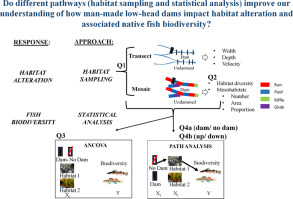Science of the Total Environment ( IF 8.2 ) Pub Date : 2017-11-14 , DOI: 10.1016/j.scitotenv.2017.10.272 Sean M. Hitchman , Martha E. Mather , Joseph M. Smith , Jane S. Fencl

|
Conserving native biodiversity depends on restoring functional habitats in the face of human-induced disturbances. Low-head dams are a ubiquitous human impact that degrades aquatic ecosystems worldwide. To improve our understanding of how low-head dams impact habitat and associated biodiversity, our research examined complex interactions among three spheres of the total environment. i.e., how low-head dams (anthroposphere) affect aquatic habitat (hydrosphere), and native biodiversity (biosphere) in streams and rivers. Creation of lake-like habitats upstream of low-head dams is a well-documented major impact of dams. Alterations downstream of low head dams also have important consequences, but these downstream dam effects are more challenging to detect. In a multidisciplinary field study at five dammed and five undammed sites within the Neosho River basin, KS, we tested hypotheses about two types of habitat sampling (transect and mosaic) and two types of statistical analyses (analysis of covariance and path analysis). We used fish as our example of biodiversity alteration. Our research provided three insights that can aid environmental professionals who seek to conserve and restore fish biodiversity in aquatic ecosystems threatened by human modifications. First, a mosaic approach identified habitat alterations below low-head dams (e.g. increased proportion of riffles) that were not detected using the more commonly-used transect sampling approach. Second, the habitat mosaic approach illustrated how low-head dams reduced natural variation in stream habitat. Third, path analysis, a statistical approach that tests indirect effects, showed how dams, habitat, and fish biodiversity interact. Specifically, path analysis revealed that low-head dams increased the proportion of riffle habitat below dams, and, as a result, indirectly increased fish species richness. Furthermore, the pool habitat that was created above low-head dams dramatically decreased fish species richness. As we show here, mosaic habitat sampling and path analysis can help conservation practitioners improve science-based management plans for disturbed aquatic systems worldwide.
中文翻译:

栖息地镶嵌和路径分析可改善低水头水坝生态系统中水生生物多样性的生物保护
保护本地生物多样性取决于在面对人为干扰时恢复功能性栖息地。低头水坝是人类无处不在的影响,它使全世界的水生生态系统退化。为了增进我们对低水头大坝如何影响栖息地和相关生物多样性的理解,我们的研究检查了整个环境的三个领域之间的复杂相互作用。例如,低头水坝(人类圈)如何影响水生生境(水圈)和原生生物多样性(生物圈))在溪流和河流中。在低水头大坝上游形成类似湖的栖息地,是有据可查的大坝的主要影响。低水头大坝下游的变化也有重要的后果,但是这些下游大坝的影响很难发现。在对堪萨斯州Neosho流域内五个有坝和五个无坝地点的多学科实地研究中,我们检验了关于两种类型的生境采样(样带和镶嵌)和两种统计分析(协方差分析和路径分析)的假设。我们以鱼类为例,说明了生物多样性的改变。我们的研究提供了三种见解,可以帮助寻求保护和恢复受人类改造威胁的水生生态系统中鱼类生物多样性的环境专业人士。首先,镶嵌法确定了低头水坝下方的栖息地变化(例如 使用更常用的样条采样方法无法检测到的浅滩的比例增加)。其次,栖息地镶嵌方法说明了低水头大坝如何减少河流栖息地的自然变化。第三,路径分析是一种测试间接影响的统计方法,它显示了水坝,栖息地和鱼类生物多样性之间的相互作用。具体而言,路径分析显示,低水头水坝增加了水坝下方浅滩栖息地的比例,因此间接增加了鱼类物种的丰富度。此外,在低水头大坝上方形成的池塘栖息地大大降低了鱼类的丰富度。正如我们在此处所示,镶嵌生境采样和路径分析可以帮助保护从业人员改善全球范围内受干扰的水生系统的基于科学的管理计划。











































 京公网安备 11010802027423号
京公网安备 11010802027423号